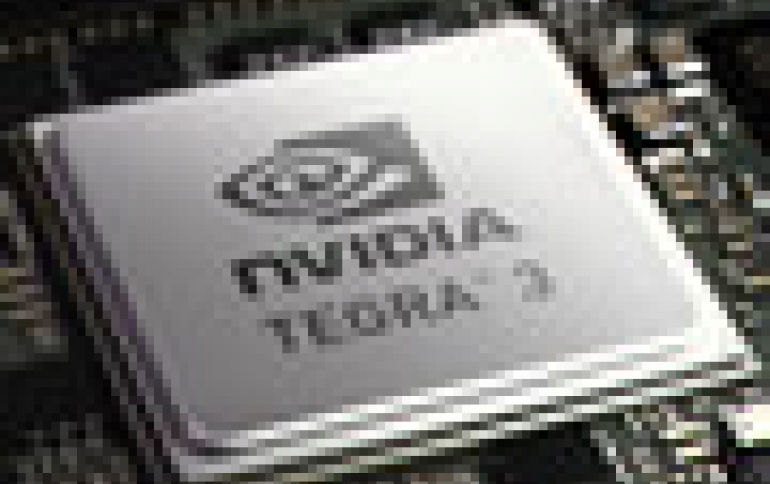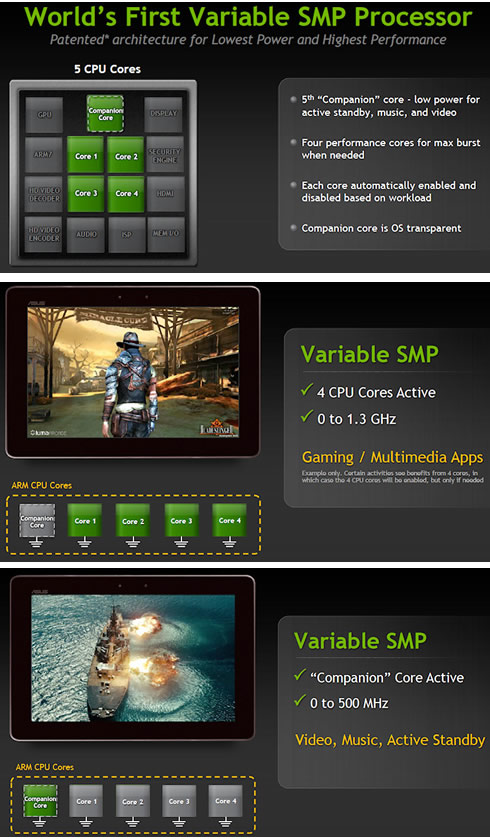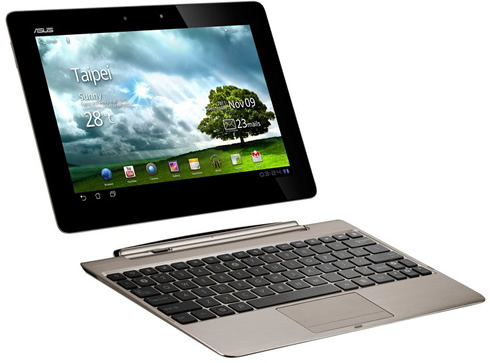
Nvidia Unveils Tegra 3 Mobile Processor
Nvidia is trying to stake out more territory in tablets and smartphones with its new Tegra 3 processor, which delivers up to three times the graphics performance of its predecessor and uses 61 percent less power.
Known previously by the codename "Project Kal-El", the new quad-core chip will
power Asustek's Eee Pad Transformer Prime, Nvidia said in a statement.
The Tegra 3 design is the first to implement four ARM Cortex A9s onto a chip aimed at the bulk of the high end Android market. NVIDIA's competitors have focused on ramping up the performance of their dual-core solutions either through higher clocks (Samsung Exynos) or through higher performing microarchitectures (Qualcomm Krait, ARM Cortex A15).
According to Nvidia, the new Tegra 3 processor provides up to 3x the graphics performance of Tegra 2, and up to 61 percent lower power consumption. This translates into a 12 hours of battery life for HD video playback.
The Tegra 3 processor implements a new, patent-pending technology known as Variable Symmetric Multiprocessing (vSMP). vSMP includes a fifth CPU "companion," designed for work requiring little power. The four main cores are designed for work requiring high performance, and Nvidia claims that they consume less power than dual-core processors.
During tasks that require less power consumption -- like listening to music, playing back video or updating background data -- the Tegra 3 processor completely shuts down its four performance-tuned cores and, instead, uses its companion core. For high-performance tasks -- like web browsing, multitasking and gaming -- the Tegra 3 processor disables the companion. Despite Tegra 3 featuring a total of five Cortex A9 cores, only four can be active at one time. Furthermore, the companion core cannot be active alongside any of the high-performance A9 chips.
Each Tegra 3 core has a 32KB/32KB L1 and all four share a 1MB L2 cache. L2 cache latency is 2 cycles faster on Tegra 3 than 2, while L1 cache latencies haven't changed.
The A9s in Tegra 3 can run at a higher max frequency than those in Tegra 2. With 1 - 3 cores active, the max clock is 1.4GHz (up from 1.0GHz in the original Tegra 2). With all four cores active however the max clock is 1.3GHz. The fifth Cortex A9 on Tegra 3 is limited to a maximum clock speed of 500MHz.

The Tegra 3 CPU is complemented with a new 12-core NVIDIA GeForce GPU, which promises to deliver more realism with dynamic lighting, physical effects and high resolution environments, plus support for 3D stereo. The new video engine offers support for 1080p high profile video at 40 Mbps.
The Image Signal Processor (ISP) in Tegra 3 is also twice as fast as what was in Tegra 2 and NVIDIA.
While Tegra 2 supported LPDDR2 at data rates of up to 600MHz, Tegra 3 increases that to LPDDR2-1066 and DDR3-L is supported at data rates of up to 1500MHz. However, the memory interface remains 32-bits wide, resulting in less theoretical bandwidth than Apple's A5, Samsung's Exynos 4210, TI's OMAP 4, or Qualcomm's upcoming MSM8960.
NVIDIA's latest SoC also includes an on-die SATA II controller, a feature that wasn't present on Tegra 2.
Nvidia also claims that the Tegra 3 processor provides a mobile gaming experience comparable to that of a game console. It offers full game-controller support, enabling users to play games on their tablet or super phone, or connect to big screen HDTVs. It also leverages NVIDIA's 3D Vision technology and automatically converts OpenGL applications to stereo 3D, so users can experience 3D on a big screen 3D TV (via HDMI 1.4 technology).
The Tegra 3 processor also features accelerated Adobe Flash Player 11, HTML5 and WebGL browsing, and an optimized Javascript engine.
ASUS' Transformer Prime
The first Tegra 3 tablet out of the gate is ASUS' Transformer Prime, which will launch in the US before the end of the year. Below you can see a comparison of the new Transofmer Prime, Apple iPad 2 and Samsung Galaxy Tab 10.1 tablets:

The Prime is much thinner than its predecessor, even thinner than the Galaxy Tab 8.9 and iPad 2 at 8.3mm. It's also the second lightest 10-inch Android tablet we've seen at 586 grams, a tad heavier than Samsung's Galaxy Tab 10.1 (565g).
The new tablet is aluminum and its display resolution is at 1280 x 800. The display is an IPS derivative ASUS is calling Super IPS+. ASUS is promising up to 600 nits in its brightest mode.
The tablet is also equipped with two cameras; 1.2MP front facing and 8MP rear facing (f/2.4) with LED flash. It also has larger speakers than its predecessor and comes with an integrated 25Wh battery.
The Transformer Prime is expected to launch in the US in December with Android 3.2, with Ice Cream Sandwich upgrade coming later.

The Tegra 3 design is the first to implement four ARM Cortex A9s onto a chip aimed at the bulk of the high end Android market. NVIDIA's competitors have focused on ramping up the performance of their dual-core solutions either through higher clocks (Samsung Exynos) or through higher performing microarchitectures (Qualcomm Krait, ARM Cortex A15).
According to Nvidia, the new Tegra 3 processor provides up to 3x the graphics performance of Tegra 2, and up to 61 percent lower power consumption. This translates into a 12 hours of battery life for HD video playback.
The Tegra 3 processor implements a new, patent-pending technology known as Variable Symmetric Multiprocessing (vSMP). vSMP includes a fifth CPU "companion," designed for work requiring little power. The four main cores are designed for work requiring high performance, and Nvidia claims that they consume less power than dual-core processors.
During tasks that require less power consumption -- like listening to music, playing back video or updating background data -- the Tegra 3 processor completely shuts down its four performance-tuned cores and, instead, uses its companion core. For high-performance tasks -- like web browsing, multitasking and gaming -- the Tegra 3 processor disables the companion. Despite Tegra 3 featuring a total of five Cortex A9 cores, only four can be active at one time. Furthermore, the companion core cannot be active alongside any of the high-performance A9 chips.
| Tegra 2 | Tegra 3 | |
| Processor | ||
| CPU | Dual-Core ARM Cortex A9 | Quad-Core ARM Cortex A9 |
| Max Frequency | Up to 1.2 GHz | Up to Single Core 1.4 GHz /Quad-Core 1.3 GHz |
| L2 Cache | 1 MB | 1 MB |
| L1 Cache (I/D) | (32KB / 32KB) per core | (32KB / 32KB) per core |
| Memory | ||
| Frequency | Up to DDR2-760 Up to LPDDR2-733 |
DDR3-L 1500 LPDDR2-1066 |
| Memory Size | Up to 1GB | Up to 2 GB |
| GPU | ||
| Architecture | ULP GeForce | ULP GeForce |
| 3D Performance Relative to Tegra 2* | Up to 1.3x | Up to 3x |
| Cores | 8 | 12 |
| 3D Stereo | No | Yes |
| Full Programmability | Yes | Yes |
| OpenGL ES Version | 2.0 | 2.0 |
| OpenVG | 1.1 | 1.1 |
| EGL | 1.4 | 1.4 |
| Video (1080p) | ||
| Decode | H.264 VC-1 AP MPEG2 MPEG-4 DivX 4/5 XviD HT H.263 Theora VP8 WMV Sorenson Spark Real Video VP6 |
H.264 (HP @ 40Mbps) VC-1 AP MPEG2 MPEG-4 DivX 4/5 XviD HT H.263 Theora VP8 WMV Sorenson Spark Real Video VP6 |
| Encode | H.264 MPEG4 H.263 VP8 |
H.264 MPEG4 H.263 VP8 |
| Video Teleconference (VTC) | H.264 MPEG4 H.263 VP8 |
H.264 MPEG4 H.263 VP8 |
| Audio | ||
| Decode | AAC-LC AAC+ eAAC+ MP3 MP3 VBR WAV/PCM AMR-NB AMR-WB BSAC MPEG-2 Audio Vorbis WMA 9 WMA Lossless WMA Pro G.729a * G.711 * QCELP * EVRC * * Through third party |
AAC-LC AAC+ eAAC+ MP3 MP3 VBR WAV/PCM AMR-NB AMR-WB BSAC MPEG-2 Audio Vorbis WMA 9 WMA Lossless WMA Pro G.729a * G.711 * QCELP * EVRC * * Through third party |
| Encode | AAC LC AAC+ eAAC+ PCM/WAV AMR-NB AMR-WB |
AAC LC AAC+ eAAC+ PCM/WAV AMR-NB AMR-WB |
| Imaging | ||
| Primary Camera | 12 MP | 32 MP |
| Secondary Camera | 5 MP | 5 MP |
| Mpixel/s | 150 | 300 |
| Digital Zoom | Up to 16x | Up to 16x |
| JPEG Decoding/Encoding | 80MP/sec | 80MP/sec |
| Still Image Stabilitization | Yes | Yes |
| Video Stabilization | Yes | Yes |
| Features | Auto Exposure Auto White Balance Auto Focus Lens Shading 9th order De-Mosaic Sharpening Programmable De-Noise |
Auto Exposure Auto White Balance Auto Focus Lens Shading 9th order De-Mosaic Sharpening Programmable De-Noise |
| MIPI CSI | Yes | Yes |
| Display | ||
| Display Controllers | 2 simultaneous | 2 simultaneous |
| HDMI | 1.3 (1920x1080) | 1.4a (1920x1080) |
| LCD | Up to 1680x1050 | 2048x1536 |
| CRT | Up to 1600x1200 | 1920x1200 |
| MIPI DSI | Yes | Yes |
| Package | ||
| Package | 12x12 PoP 23x23 BGA |
14x14 BGA 23x23 BGA |
| Process | 40 nm | 40 nm |
Each Tegra 3 core has a 32KB/32KB L1 and all four share a 1MB L2 cache. L2 cache latency is 2 cycles faster on Tegra 3 than 2, while L1 cache latencies haven't changed.
The A9s in Tegra 3 can run at a higher max frequency than those in Tegra 2. With 1 - 3 cores active, the max clock is 1.4GHz (up from 1.0GHz in the original Tegra 2). With all four cores active however the max clock is 1.3GHz. The fifth Cortex A9 on Tegra 3 is limited to a maximum clock speed of 500MHz.

The Tegra 3 CPU is complemented with a new 12-core NVIDIA GeForce GPU, which promises to deliver more realism with dynamic lighting, physical effects and high resolution environments, plus support for 3D stereo. The new video engine offers support for 1080p high profile video at 40 Mbps.
The Image Signal Processor (ISP) in Tegra 3 is also twice as fast as what was in Tegra 2 and NVIDIA.
While Tegra 2 supported LPDDR2 at data rates of up to 600MHz, Tegra 3 increases that to LPDDR2-1066 and DDR3-L is supported at data rates of up to 1500MHz. However, the memory interface remains 32-bits wide, resulting in less theoretical bandwidth than Apple's A5, Samsung's Exynos 4210, TI's OMAP 4, or Qualcomm's upcoming MSM8960.
NVIDIA's latest SoC also includes an on-die SATA II controller, a feature that wasn't present on Tegra 2.
Nvidia also claims that the Tegra 3 processor provides a mobile gaming experience comparable to that of a game console. It offers full game-controller support, enabling users to play games on their tablet or super phone, or connect to big screen HDTVs. It also leverages NVIDIA's 3D Vision technology and automatically converts OpenGL applications to stereo 3D, so users can experience 3D on a big screen 3D TV (via HDMI 1.4 technology).
The Tegra 3 processor also features accelerated Adobe Flash Player 11, HTML5 and WebGL browsing, and an optimized Javascript engine.
ASUS' Transformer Prime
The first Tegra 3 tablet out of the gate is ASUS' Transformer Prime, which will launch in the US before the end of the year. Below you can see a comparison of the new Transofmer Prime, Apple iPad 2 and Samsung Galaxy Tab 10.1 tablets:
| ASUS Eee Pad Transformer Prime | Apple iPad 2 | Samsung Galaxy Tab 10.1 | |
| Dimensions | 263 x 180.8 x 8.3mm | 241.2 x 185.7 x 8.8mm | 256.6 x 172.9 x 8.6mm |
| Display | 10.1-inch 1280 x 800 IPS | 9.7-inch 1024 x 768 IPS | 10.1-inch 1280 x 800 PLS |
| Weight | 586g | 601g | 565g |
| Processor | 1.3GHz NVIDIA Tegra 3 (4 x Cortex A9) | 1GHz Apple A5 (2 x Cortex A9) | 1GHz NVIDIA Tegra 2 (2 x Cortex A9) |
| Memory | 1GB | 512MB | 1GB |
| Storage | 32GB/64GB + microSD slot | 16GB | 16GB |
| Pricing | $499/$599 | $499 | $499 |

The Prime is much thinner than its predecessor, even thinner than the Galaxy Tab 8.9 and iPad 2 at 8.3mm. It's also the second lightest 10-inch Android tablet we've seen at 586 grams, a tad heavier than Samsung's Galaxy Tab 10.1 (565g).
The new tablet is aluminum and its display resolution is at 1280 x 800. The display is an IPS derivative ASUS is calling Super IPS+. ASUS is promising up to 600 nits in its brightest mode.
The tablet is also equipped with two cameras; 1.2MP front facing and 8MP rear facing (f/2.4) with LED flash. It also has larger speakers than its predecessor and comes with an integrated 25Wh battery.
The Transformer Prime is expected to launch in the US in December with Android 3.2, with Ice Cream Sandwich upgrade coming later.






















